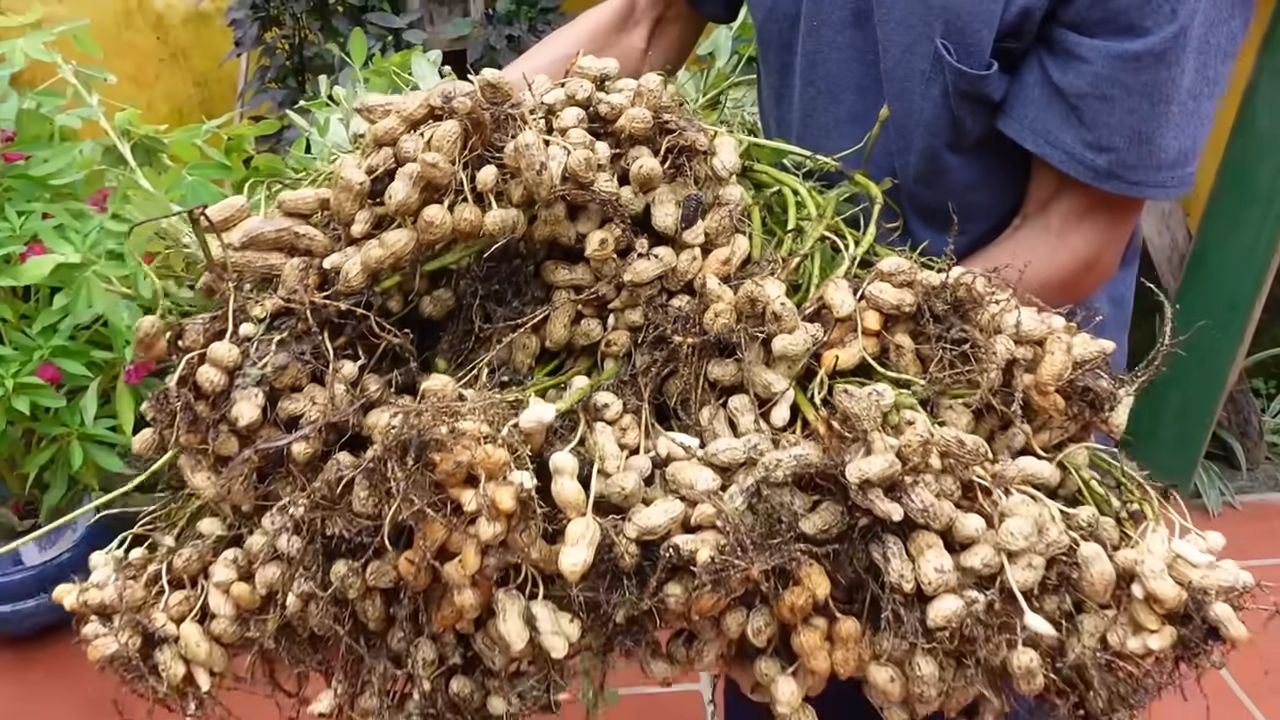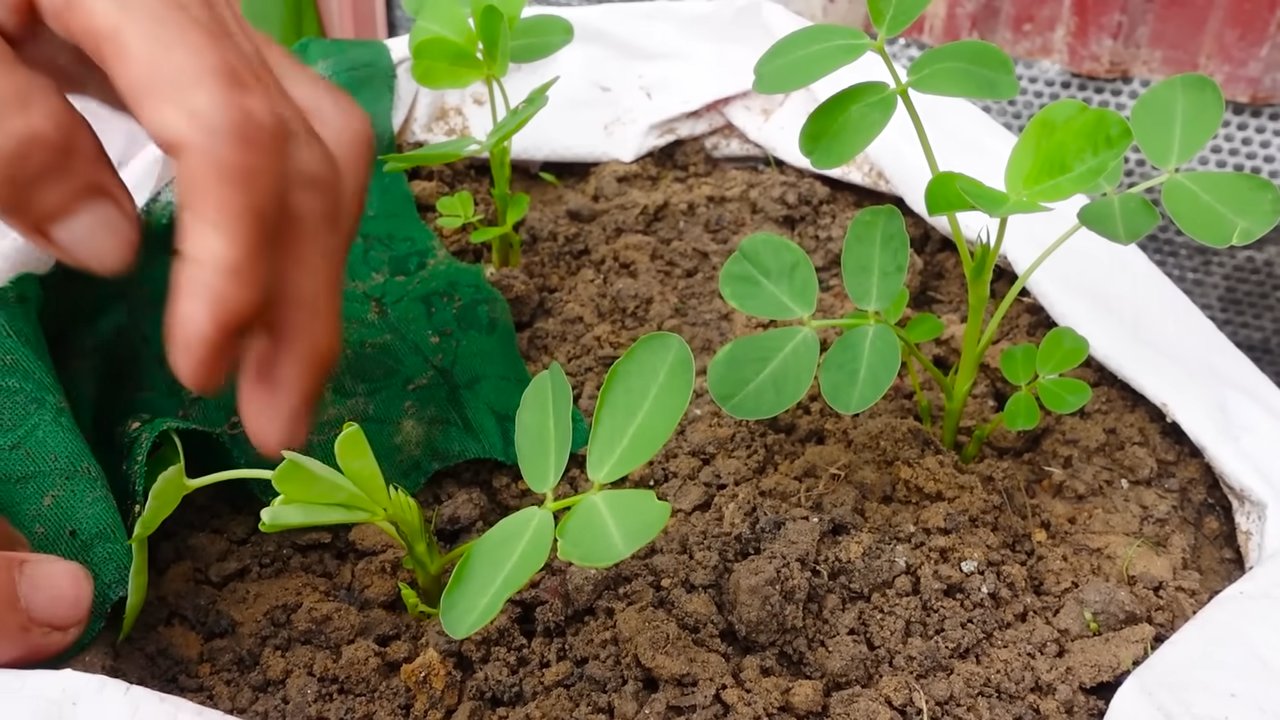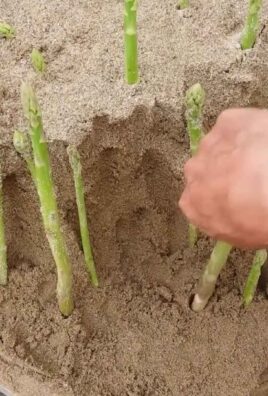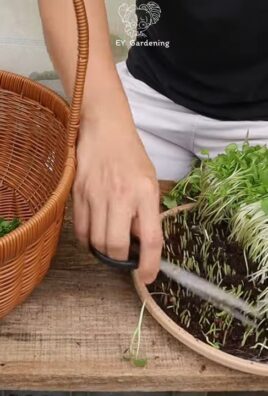Grow peanuts at home? Absolutely! Imagine the satisfaction of harvesting your own homegrown peanuts, ready to be roasted, turned into creamy peanut butter, or simply enjoyed as a healthy snack. It’s easier than you might think, and this DIY guide will walk you through every step of the process.
Peanuts, also known as groundnuts, have a rich history, dating back thousands of years to South America. They weren’t always a staple in Western diets; their popularity surged in the late 19th and early 20th centuries, thanks in part to agricultural innovations and the work of George Washington Carver, who discovered hundreds of uses for the humble peanut. Today, they are a beloved snack and a crucial ingredient in cuisines worldwide.
Why should you try to grow peanuts at home? Well, for starters, you’ll have access to fresher, tastier peanuts than you can typically find in stores. Plus, it’s a fantastic way to connect with nature, learn about the growing process, and enjoy the fruits (or rather, nuts!) of your labor. With rising food costs and a growing interest in sustainable living, learning to grow your own food, even something as seemingly simple as peanuts, is a rewarding and empowering experience. So, let’s dive in and discover the secrets to successfully cultivating peanuts in your own backyard!

Growing Peanuts at Home: A Beginner’s Guide
Hey there, fellow gardening enthusiasts! Ever thought about growing your own peanuts? It’s easier than you might think, and the satisfaction of harvesting your own homegrown peanuts is truly rewarding. I’ve been growing peanuts for a few years now, and I’m excited to share my tips and tricks with you. Let’s dive in!
Choosing the Right Peanut Variety
Before we get started, it’s important to choose the right peanut variety for your climate and growing conditions. There are four main types of peanuts:
* Runner Peanuts: These are the most common type, known for their uniform size and excellent flavor. They mature in about 120-130 days.
* Virginia Peanuts: These are the largest type of peanut, often used for roasting and snacking. They take around 130-150 days to mature.
* Spanish Peanuts: These have a reddish-brown skin and a nutty flavor. They mature the quickest, in about 110-120 days.
* Valencia Peanuts: These have multiple peanuts per shell and a sweet flavor. They mature in about 90-110 days, making them a great choice for shorter growing seasons.
I personally prefer Virginia peanuts because of their size and flavor, but choose the variety that best suits your needs and climate.
Preparing Your Peanut Planting Area
Peanuts need plenty of sunshine and well-drained soil to thrive. Here’s how to prepare your planting area:
* Sunlight: Choose a spot that gets at least 6-8 hours of direct sunlight per day.
* Soil: Peanuts prefer sandy loam soil with a pH between 6.0 and 6.5. If your soil is heavy clay, amend it with compost, peat moss, or sand to improve drainage.
* Nutrients: Peanuts are legumes, which means they can fix nitrogen from the air. However, they still benefit from a balanced fertilizer. I like to use a fertilizer with a ratio of 5-10-10 (nitrogen-phosphorus-potassium) before planting.
* Weed Control: Clear the area of weeds, as they can compete with your peanut plants for nutrients and sunlight.
Planting Your Peanuts
Now comes the fun part – planting your peanuts!
1. Timing: Plant your peanuts after the last frost, when the soil temperature is consistently above 65°F (18°C). I usually wait until late spring or early summer.
2. Shelling: Gently crack open the peanut shells and remove the peanuts. Be careful not to damage the peanuts themselves. You can plant peanuts in the shell, but they will germinate faster if you remove them.
3. Soaking (Optional): Soaking the peanuts in water for a few hours before planting can help speed up germination. I usually soak mine overnight.
4. Planting Depth: Plant the peanuts about 1-2 inches deep and 6-8 inches apart in rows that are 2-3 feet apart.
5. Watering: Water the soil thoroughly after planting. Keep the soil consistently moist, but not waterlogged, until the peanuts germinate.
Caring for Your Peanut Plants
Once your peanut plants have sprouted, it’s important to provide them with proper care to ensure a bountiful harvest.
* Watering: Water your peanut plants regularly, especially during dry spells. Aim for about 1 inch of water per week.
* Weeding: Keep the area around your peanut plants free of weeds. Hand-pull weeds carefully to avoid disturbing the peanut roots.
* Fertilizing: Fertilize your peanut plants every 4-6 weeks with a balanced fertilizer. Avoid over-fertilizing with nitrogen, as this can promote leafy growth at the expense of peanut production.
* Hilling: When the peanut plants are about 6 inches tall, hill the soil around the base of the plants. This will encourage the pegs (the stems that produce the peanuts) to enter the soil.
* Calcium: Peanuts need calcium to develop properly. If your soil is deficient in calcium, you can add gypsum (calcium sulfate) to the soil. I usually add gypsum when I hill the plants.
* Pest Control: Peanuts can be susceptible to pests such as aphids, spider mites, and leafhoppers. Inspect your plants regularly and treat any infestations promptly. I prefer to use organic pest control methods, such as insecticidal soap or neem oil.
Harvesting Your Peanuts
Harvesting is the most exciting part of growing peanuts! Here’s how to know when it’s time to harvest:
1. Timing: Peanuts are typically ready to harvest in the fall, about 120-150 days after planting, depending on the variety.
2. Signs of Maturity: The leaves of the peanut plants will start to turn yellow and brown, and the peanuts inside the shells will be plump and well-formed.
3. Digging: Use a garden fork or shovel to carefully dig up the peanut plants. Be gentle to avoid damaging the peanuts.
4. Shaking: Shake off the excess soil from the peanut plants.
5. Drying: Hang the peanut plants upside down in a well-ventilated area to dry for 2-4 weeks. This will allow the peanuts to cure and develop their flavor. I usually hang them in my garage.
Curing and Storing Your Peanuts
After the peanuts have dried, it’s time to cure and store them.
1. Picking: Once the peanut plants are dry, pick the peanuts off the plants.
2. Washing: Wash the peanuts in clean water to remove any remaining soil.
3. Drying (Again): Spread the peanuts out on a screen or tray to dry completely. This may take several days.
4. Storing: Store the dried peanuts in an airtight container in a cool, dry place. They should last for several months. I like to store mine in the refrigerator to keep them fresh longer.
Roasting Your Homegrown Peanuts
Roasting your own peanuts is a delicious way to enjoy your harvest.
1. Preheating: Preheat your oven to 350°F (175°C).
2. Preparing: Spread the peanuts out in a single layer on a baking sheet.
3. Roasting: Roast the peanuts for 20-25 minutes, or until they are golden brown and fragrant. Stir them occasionally to ensure even roasting.
4. Cooling: Let the peanuts cool completely before eating.
5. Salting (Optional): Sprinkle the roasted peanuts with salt to taste.
Troubleshooting Common Peanut Growing Problems
Even with the best care, you may encounter some problems when growing peanuts. Here are some common issues and how to address them:
* Poor Germination: If your peanuts aren’t germinating, make sure the soil temperature is warm enough and that the soil is consistently moist. You can also try soaking the peanuts before planting.
* Yellowing Leaves: Yellowing leaves can be a sign of nutrient deficiency. Fertilize your plants with a balanced fertilizer.
* Small Peanuts: Small peanuts can be caused by a lack of calcium. Add gypsum to the soil.
* Pest Infestations: Inspect your plants regularly for pests and treat any infestations promptly.
* Disease: Peanuts can be susceptible to diseases such as leaf spot and rust. Choose disease-resistant varieties and practice good sanitation to prevent disease.
Enjoying Your Homegrown Peanuts
Growing your own peanuts is a rewarding experience that allows you to enjoy fresh, delicious peanuts straight from your garden. Whether you roast them, boil them, or use them in your favorite recipes, I hope you enjoy the fruits (or rather, the nuts) of your labor!
Remember to be patient and persistent, and you’ll be rewarded with a bountiful harvest of homegrown peanuts. Happy gardening!

Conclusion
So, there you have it! Growing peanuts at home is not only achievable, but it’s also a deeply rewarding experience. Forget the store-bought peanuts, often laden with preservatives and lacking that fresh, earthy flavor. Imagine the satisfaction of harvesting your own crop, knowing exactly where they came from and how they were grown. This DIY project is more than just a gardening endeavor; it’s a connection to nature, a lesson in sustainability, and a delicious treat all rolled into one.
Why is this a must-try? Because it’s surprisingly simple! With just a few basic supplies, a sunny spot, and a little patience, you can cultivate your own peanut patch. It’s a fantastic project for families, teaching children about the life cycle of plants and the importance of healthy eating. Plus, the taste of homegrown peanuts is simply unparalleled. They’re sweeter, nuttier, and bursting with flavor that you just can’t find in commercially produced varieties.
But the fun doesn’t stop there! Feel free to experiment with different varieties of peanuts. Virginia peanuts are known for their large size and are perfect for roasting. Spanish peanuts are smaller and sweeter, ideal for candies and snacks. Runner peanuts are commonly used for peanut butter, so if you’re a peanut butter aficionado, this is the variety for you. You can also try different roasting methods – oven-roasted, pan-roasted, or even grilled – to find your perfect peanut flavor profile. Consider adding spices like chili powder, smoked paprika, or garlic powder for a savory twist.
Don’t be afraid to get creative with your peanut harvest! Beyond simply snacking on them, use your homegrown peanuts in a variety of dishes. Add them to stir-fries for a crunchy texture, sprinkle them on salads for a nutty flavor, or grind them into homemade peanut butter. The possibilities are endless!
We wholeheartedly encourage you to embark on this peanut-growing adventure. It’s a chance to connect with nature, learn new skills, and enjoy the delicious fruits (or rather, nuts!) of your labor. And most importantly, we want to hear about your experience! Share your photos, tips, and stories with us. Let us know what varieties you tried, what challenges you faced, and what delicious creations you made with your homegrown peanuts. Your feedback will not only inspire others to try this rewarding DIY trick, but it will also help us refine and improve our guide for future peanut growers. So, grab your seeds, get your hands dirty, and get ready to enjoy the unparalleled taste of homegrown peanuts! Let’s cultivate a community of peanut enthusiasts, one backyard garden at a time.
Frequently Asked Questions (FAQ)
What is the best time of year to plant peanuts?
The ideal time to plant peanuts is in the spring, after the last frost has passed and the soil has warmed up to at least 65 degrees Fahrenheit. Peanuts need a long growing season, typically around 120-150 days, so starting them early in the spring will give them ample time to mature before the first frost of fall. In warmer climates with longer growing seasons, you may be able to plant peanuts later in the spring or even early summer. However, it’s crucial to ensure they have enough time to fully develop before the weather turns cold. Check your local weather forecasts and planting guides for specific recommendations based on your region’s climate.
What kind of soil is best for growing peanuts?
Peanuts thrive in well-drained, sandy loam soil. This type of soil allows for good aeration and drainage, which is essential for healthy root development and prevents the peanuts from rotting. Avoid heavy clay soils, as they can become waterlogged and compact, hindering the growth of the peanut plants. The soil should also be slightly acidic, with a pH level between 6.0 and 6.5. Before planting, it’s a good idea to amend your soil with compost or other organic matter to improve its drainage and fertility. You can also add a small amount of gypsum to provide calcium, which is important for peanut development.
How much sunlight do peanuts need?
Peanuts require at least 6-8 hours of direct sunlight per day to thrive. Sunlight is essential for photosynthesis, the process by which plants convert light energy into chemical energy for growth. Choose a planting location that receives plenty of sunlight throughout the day. If you’re growing peanuts in containers, make sure to place them in a sunny spot on your patio or balcony. If you live in a particularly hot climate, you may need to provide some afternoon shade to prevent the plants from getting scorched.
How often should I water my peanut plants?
Peanut plants need consistent moisture, especially during the flowering and pegging stages. Water deeply and regularly, ensuring that the soil remains moist but not waterlogged. Avoid overhead watering, as this can promote fungal diseases. Instead, water at the base of the plants, using a soaker hose or drip irrigation system. The frequency of watering will depend on the weather conditions and the type of soil you have. In hot, dry weather, you may need to water daily, while in cooler, wetter weather, you can water less frequently. Check the soil moisture regularly by sticking your finger into the soil. If the top inch of soil feels dry, it’s time to water.
How do I know when my peanuts are ready to harvest?
Determining the right time to harvest peanuts is crucial for ensuring optimal flavor and yield. The best way to tell if your peanuts are ready is to dig up a few plants and examine the pods. The pods should be fully developed, with a network of veins on the shell. The inside of the shell should be dark in color, and the kernels should be plump and fill the entire pod. Another indicator is the yellowing of the leaves. As the peanuts mature, the leaves will start to turn yellow and brown. Typically, peanuts are ready to harvest about 120-150 days after planting.
Can I grow peanuts in containers?
Yes, you can absolutely grow peanuts in containers! This is a great option if you have limited space or live in an apartment. Choose a large container, at least 18 inches in diameter and 12 inches deep, to provide enough room for the roots to grow. Fill the container with well-draining potting mix and plant your peanut seeds or seedlings. Make sure the container receives plenty of sunlight and water regularly. Container-grown peanuts may require more frequent watering and fertilization than those grown in the ground.
What are some common pests and diseases that affect peanuts?
Peanuts can be susceptible to various pests and diseases, including aphids, spider mites, leafhoppers, and fungal diseases like leaf spot and white mold. To prevent pest and disease problems, practice good garden hygiene. Remove weeds and debris from around the plants, and water at the base of the plants to avoid wetting the foliage. You can also use organic pest control methods, such as insecticidal soap or neem oil, to control aphids and spider mites. For fungal diseases, apply a fungicide according to the manufacturer’s instructions. Crop rotation can also help to prevent soilborne diseases.
How do I cure and store my harvested peanuts?
After harvesting your peanuts, it’s important to cure them properly to prevent mold and spoilage. To cure peanuts, spread them out in a single layer on a screen or wire rack in a well-ventilated area. Allow them to dry for several weeks, until the shells are completely dry and brittle. Once the peanuts are cured, you can store them in airtight containers in a cool, dry place. Properly cured and stored peanuts can last for several months. You can also freeze peanuts for longer storage.





Leave a Comment